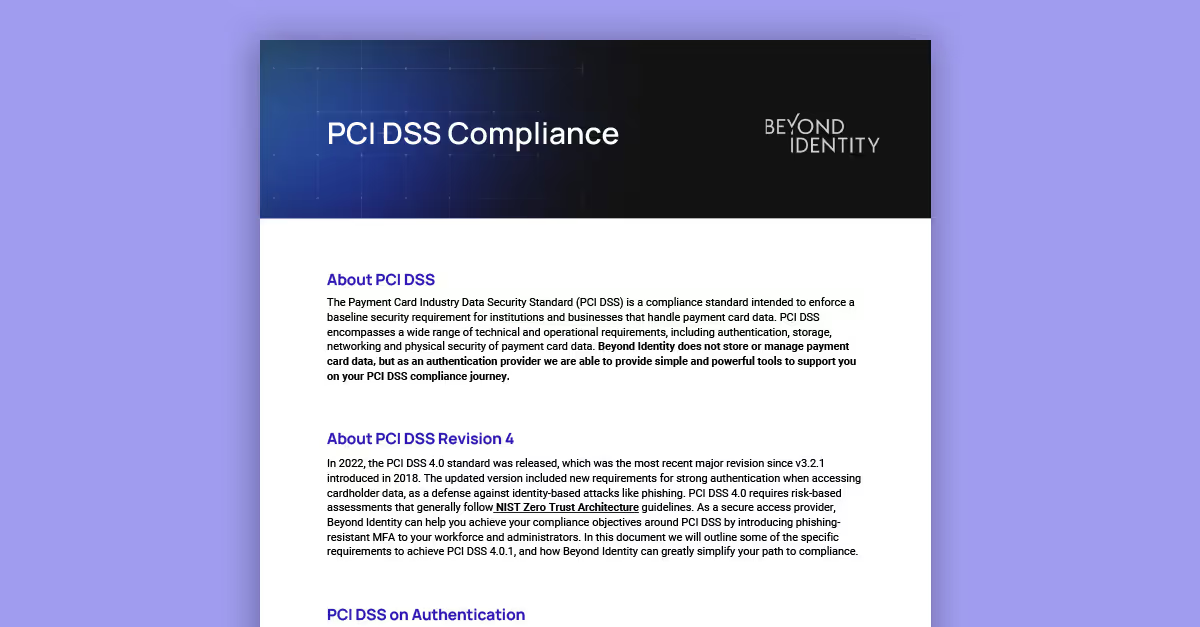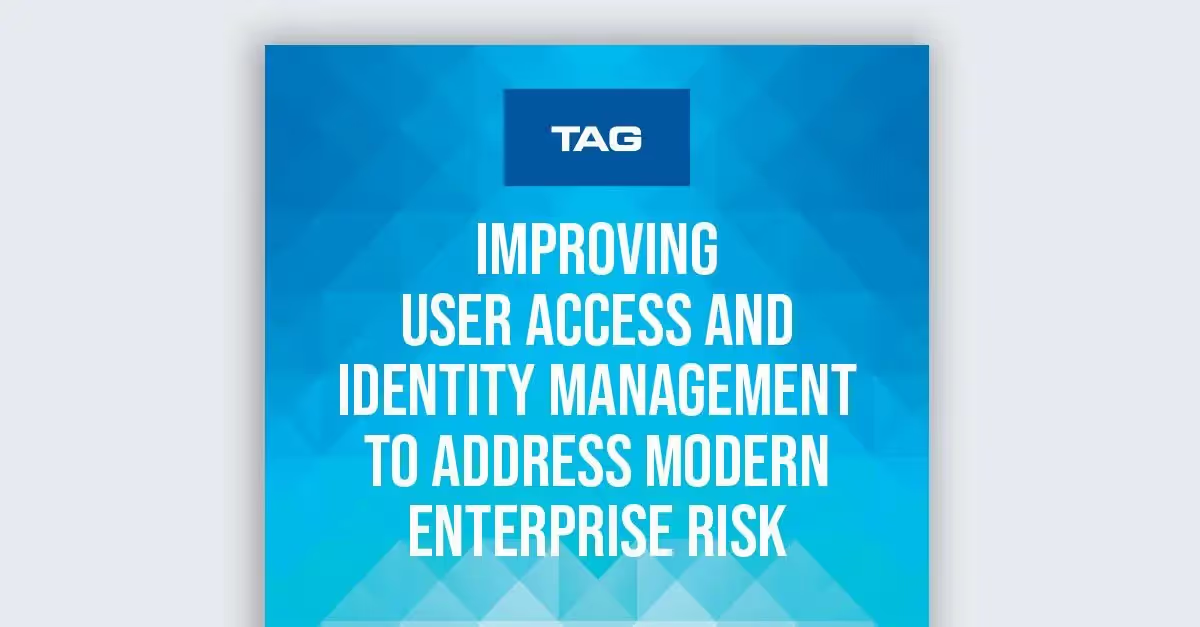Make Identity-Based Attacks Impossible
Make Identity-Based Attacks Impossible
Abstract
Identity-based attacks are the #1 cause of enterprise security incidents because they are adversaries' preferred paths into enterprise environments. The threat is also accelerating with the proliferation of AI, remote work, and cloud applications.
According to CrowdStrike's 2025 Threat Hunting Report, 52% of vulnerabilities observed by CrowdStrike in 2024 were related to initial access, voice phishing increasing by 442%, and the report concludes with a specific emphasis on the “rapid rise of identity-based attacks”.
Given the scale of identity-based attacks, the elimination of such attacks means a drastic reduction in security and IT incident response.
This whitepaper outlines how Beyond Identity’s Adaptive Identity Defense architecture eliminates identity-based attacks by design.
By binding authentication to non-exportable Device-Bound Credentials (DBC), enforcing risk-based policy controls with real-time security telemetry, continuously validating session integrity, and removing the concept of static credentials entirely, Beyond Identity dismantles the foundational techniques adversaries rely on.
Using the MITRE ATT&CK framework as a reference, this paper shows how Beyond Identity’s defensive controls can defeat common Tactics, Techniques, and Procedures (TTPs), rendering identity exploitation structurally impossible.
The Problem: Identity Is the New Perimeter and Attack Surface
The 2025 Verizon Data Breach Investigations Report (DBIR), Mandiant's M-Trends, and CrowdStrike’s Global Threat Report continue to show the same root cause behind the majority of attacks:
- Compromised credentials
- Weak or phishable MFA
- Unmanaged device access
- Token/session theft and reuse
- Lack of posture validation after login
These threats point to the fact that modern threat actors exploit weak identity primitives across enterprise environments. Despite widespread adoption of MFA, attackers routinely bypass these defenses using adversary-in-the-middle tactics, MFA bombing, and stolen credentials.
This creates an opportunity for attackers to exploit credentials, replay tokens, move laterally, or escalate access through unmanaged endpoints. Beyond Identity eliminates these attack vectors by anchoring identity verification, trust, and access control as architectural guarantees, not reactive detections or probabilistic assessments.
The Beyond Identity Approach: Prevent, Don’t Just Detect
Beyond Identity refutes the fundamentally mistaken notion that more factors = more security. Instead of layering on weak factors in hopes of creating a stronger access control (but ultimately frustrating end users), the platform delivers an identity security solution that eliminates passwords, shared secrets, phishable credentials, and static trust.
Core Principles
Beyond Identity eliminates identity-based attacks, not by detecting them faster, but by making the underlying techniques structurally impossible. Its architecture enforces five non-negotiable principles:
1. Device-Bound Credentials
- Each credential is a unique public-private key pair generated on the endpoint during registration.
- The private key is generated and protected using secure hardware (TPM, Secure Enclave, or Android Keystore) and is non-exportable by design.
- No credential material—no passwords, OTPs, or passkeys—is ever stored, transmitted, or cached.
Result: Even if an attacker gains root access, they cannot extract a key to reuse elsewhere. No extractable credential = no lateral movement, no impersonation, no compromise.
2. Origin Binding and Application Context Enforcement
- Every authentication request is cryptographically bound to its origin and application context.
- A credential will only sign a request if it originates from the expected domain, application, and TLS session.
- This blocks adversary-in-the-middle tools (like Evilginx or transparent proxies) that rely on intercepting credentials in transit.
Result: Even if the user clicks a phishing link that attempts to intercept credentials, nothing bad happens because authentication will not complete. Phishing pages, session hijack attempts, and browser token exfiltration are dead on arrival.
3. Local User Presence Enforcement
- Authentication requires a biometric or OS-level unlock, verified locally on the user’s endpoint.
- This ensures the human in possession of the device is the one initiating the action—no remote attacker can spoof or socially engineer their way in.
- There are no push notifications to intercept, fatigue, or coerce approval from.
Result: Prompt bombing and MFA spam are categorically impossible. Even tricking the user does nothing without physical device presence. Plus, on the human side of things, without relying on a second device means you can avoid the end-user debate of “why should I use my phone to login?”.
4. Continuous Session Validation
- Beyond Identity treats sessions as dynamic objects, not static tokens. Each session is continuously assessed in real time.
- Session integrity is tied to device posture, geolocation, network conditions, user behavior, and threat intel signals.
- Policies can terminate or quarantine sessions on posture drift, identity anomalies, or known exploit conditions.
Result: Compromised sessions can’t persist or move laterally. Every access request is a fresh challenge, not a cached assumption.
5. Deep Security Posture Inference and Enforcement
- The Beyond Identity platform authenticator collects deep, tamper-resistant telemetry from the device whether it’s managed or unmanaged, including:
- OS version and patch level
- Disk encryption status
- Secure boot ancd jailbreak/root detection
- Application and process integrity
- This is augmented by integrations with the security ecosystem:
- MDMs for compliance and configuration enforcement
- EDR/XDR platforms for threat telemetry
- ZTNA platforms for dynamic trust zones
- SIEM/SOAR for contextual decisioning
- Policy enforcement is dynamic: posture is not just checked once, but continuously verified, and federated across the ecosystem.
Result: Identity is not just who you are, but what you’re running, where you are, and whether your device has the appropriate security controls to gain access to the environment. If any of these are out of line, access to critical resources is instantly revoked.
What Beyond Identity Prevents by Design, Mapped to MITRE
The following section outlines how Beyond Identity’s platform maps to key identity-based TTPs in the MITRE ATT&CK framework.
Detailed Attack Scenario Defense
Attack Technique: T1566 – Phishing
Phishing is still winning. Despite billions spent on training and email filters, attackers keep getting in—16% of breaches start with a phish, and even after training, nearly 1 in 20 employees still click (Verizon DBIR, KnowBe4). As phishing evolves with AI and voice-based lures, the problem isn’t shrinking, it’s accelerating.
Defense: Device-bound credential, origin verification, local user authentication.
Known Threat Actors using T1566:
- Scattered Spider sent phishing messages via SMS to steal credentials to compromise telecommunications industry
- Lazarus Group used spearphishing emails and fake job offers to trick victims into downloading malware and exposing credentials
- FIN7 used phishing emails with malicious attachments to breach U.S. retail and hospitality companies
Technique Walkthrough vs Beyond Identity Defense
Attack Technique: T1552.001 – Credentials in Registry
Defense: No secrets stored, no credentials created at time of desktop login.
Known Threat Actors using Credentials in Registry:
- APT32 harvests credentials stored in Windows Registry
- RedCurl uses widely available open-sourced tool to obtain passwords in the Registry
Attack Technique: T1621 – MFA Request Generation (Fatigue)
Defense: No push notifications, local presence with cryptographic verification.
Known Threat Actors using T1621:
- LAPSUS$ targets legitimate users with MFA prompt spam
- Scattered Spider continuously sends MFA messages until the push challenge is accepted
- APT29 uses repeated MFA requests to gain unauthorized access
Attack Technique: T1111 – MFA Interception
Known Threat Actors using T1111:
- APT42 intercepts one-time codes and closes fake login pages to capture MFA tokens
- LAPSUS$ replays stolen session tokens and passwords
- Chimera registers phone numbers to intercept MFA codes sent via MFA
Defense: No secrets stored. Cryptographic challenges signed by verified devices make replay and injection attacks impossible.
Conclusion
Beyond Identity makes identity-based attacks impossible by structurally eradicating the mechanisms adversaries rely on. No shared secrets. No access without posture. No sessions without continuous trust.
Watch a 12 minute demo on your own time, or schedule a personalized demo tailored to your environment.
Make Identity-Based Attacks Impossible
Abstract
Identity-based attacks are the #1 cause of enterprise security incidents because they are adversaries' preferred paths into enterprise environments. The threat is also accelerating with the proliferation of AI, remote work, and cloud applications.
According to CrowdStrike's 2025 Threat Hunting Report, 52% of vulnerabilities observed by CrowdStrike in 2024 were related to initial access, voice phishing increasing by 442%, and the report concludes with a specific emphasis on the “rapid rise of identity-based attacks”.
Given the scale of identity-based attacks, the elimination of such attacks means a drastic reduction in security and IT incident response.
This whitepaper outlines how Beyond Identity’s Adaptive Identity Defense architecture eliminates identity-based attacks by design.
By binding authentication to non-exportable Device-Bound Credentials (DBC), enforcing risk-based policy controls with real-time security telemetry, continuously validating session integrity, and removing the concept of static credentials entirely, Beyond Identity dismantles the foundational techniques adversaries rely on.
Using the MITRE ATT&CK framework as a reference, this paper shows how Beyond Identity’s defensive controls can defeat common Tactics, Techniques, and Procedures (TTPs), rendering identity exploitation structurally impossible.
The Problem: Identity Is the New Perimeter and Attack Surface
The 2025 Verizon Data Breach Investigations Report (DBIR), Mandiant's M-Trends, and CrowdStrike’s Global Threat Report continue to show the same root cause behind the majority of attacks:
- Compromised credentials
- Weak or phishable MFA
- Unmanaged device access
- Token/session theft and reuse
- Lack of posture validation after login
These threats point to the fact that modern threat actors exploit weak identity primitives across enterprise environments. Despite widespread adoption of MFA, attackers routinely bypass these defenses using adversary-in-the-middle tactics, MFA bombing, and stolen credentials.
This creates an opportunity for attackers to exploit credentials, replay tokens, move laterally, or escalate access through unmanaged endpoints. Beyond Identity eliminates these attack vectors by anchoring identity verification, trust, and access control as architectural guarantees, not reactive detections or probabilistic assessments.
The Beyond Identity Approach: Prevent, Don’t Just Detect
Beyond Identity refutes the fundamentally mistaken notion that more factors = more security. Instead of layering on weak factors in hopes of creating a stronger access control (but ultimately frustrating end users), the platform delivers an identity security solution that eliminates passwords, shared secrets, phishable credentials, and static trust.
Core Principles
Beyond Identity eliminates identity-based attacks, not by detecting them faster, but by making the underlying techniques structurally impossible. Its architecture enforces five non-negotiable principles:
1. Device-Bound Credentials
- Each credential is a unique public-private key pair generated on the endpoint during registration.
- The private key is generated and protected using secure hardware (TPM, Secure Enclave, or Android Keystore) and is non-exportable by design.
- No credential material—no passwords, OTPs, or passkeys—is ever stored, transmitted, or cached.
Result: Even if an attacker gains root access, they cannot extract a key to reuse elsewhere. No extractable credential = no lateral movement, no impersonation, no compromise.
2. Origin Binding and Application Context Enforcement
- Every authentication request is cryptographically bound to its origin and application context.
- A credential will only sign a request if it originates from the expected domain, application, and TLS session.
- This blocks adversary-in-the-middle tools (like Evilginx or transparent proxies) that rely on intercepting credentials in transit.
Result: Even if the user clicks a phishing link that attempts to intercept credentials, nothing bad happens because authentication will not complete. Phishing pages, session hijack attempts, and browser token exfiltration are dead on arrival.
3. Local User Presence Enforcement
- Authentication requires a biometric or OS-level unlock, verified locally on the user’s endpoint.
- This ensures the human in possession of the device is the one initiating the action—no remote attacker can spoof or socially engineer their way in.
- There are no push notifications to intercept, fatigue, or coerce approval from.
Result: Prompt bombing and MFA spam are categorically impossible. Even tricking the user does nothing without physical device presence. Plus, on the human side of things, without relying on a second device means you can avoid the end-user debate of “why should I use my phone to login?”.
4. Continuous Session Validation
- Beyond Identity treats sessions as dynamic objects, not static tokens. Each session is continuously assessed in real time.
- Session integrity is tied to device posture, geolocation, network conditions, user behavior, and threat intel signals.
- Policies can terminate or quarantine sessions on posture drift, identity anomalies, or known exploit conditions.
Result: Compromised sessions can’t persist or move laterally. Every access request is a fresh challenge, not a cached assumption.
5. Deep Security Posture Inference and Enforcement
- The Beyond Identity platform authenticator collects deep, tamper-resistant telemetry from the device whether it’s managed or unmanaged, including:
- OS version and patch level
- Disk encryption status
- Secure boot ancd jailbreak/root detection
- Application and process integrity
- This is augmented by integrations with the security ecosystem:
- MDMs for compliance and configuration enforcement
- EDR/XDR platforms for threat telemetry
- ZTNA platforms for dynamic trust zones
- SIEM/SOAR for contextual decisioning
- Policy enforcement is dynamic: posture is not just checked once, but continuously verified, and federated across the ecosystem.
Result: Identity is not just who you are, but what you’re running, where you are, and whether your device has the appropriate security controls to gain access to the environment. If any of these are out of line, access to critical resources is instantly revoked.
What Beyond Identity Prevents by Design, Mapped to MITRE
The following section outlines how Beyond Identity’s platform maps to key identity-based TTPs in the MITRE ATT&CK framework.
Detailed Attack Scenario Defense
Attack Technique: T1566 – Phishing
Phishing is still winning. Despite billions spent on training and email filters, attackers keep getting in—16% of breaches start with a phish, and even after training, nearly 1 in 20 employees still click (Verizon DBIR, KnowBe4). As phishing evolves with AI and voice-based lures, the problem isn’t shrinking, it’s accelerating.
Defense: Device-bound credential, origin verification, local user authentication.
Known Threat Actors using T1566:
- Scattered Spider sent phishing messages via SMS to steal credentials to compromise telecommunications industry
- Lazarus Group used spearphishing emails and fake job offers to trick victims into downloading malware and exposing credentials
- FIN7 used phishing emails with malicious attachments to breach U.S. retail and hospitality companies
Technique Walkthrough vs Beyond Identity Defense
Attack Technique: T1552.001 – Credentials in Registry
Defense: No secrets stored, no credentials created at time of desktop login.
Known Threat Actors using Credentials in Registry:
- APT32 harvests credentials stored in Windows Registry
- RedCurl uses widely available open-sourced tool to obtain passwords in the Registry
Attack Technique: T1621 – MFA Request Generation (Fatigue)
Defense: No push notifications, local presence with cryptographic verification.
Known Threat Actors using T1621:
- LAPSUS$ targets legitimate users with MFA prompt spam
- Scattered Spider continuously sends MFA messages until the push challenge is accepted
- APT29 uses repeated MFA requests to gain unauthorized access
Attack Technique: T1111 – MFA Interception
Known Threat Actors using T1111:
- APT42 intercepts one-time codes and closes fake login pages to capture MFA tokens
- LAPSUS$ replays stolen session tokens and passwords
- Chimera registers phone numbers to intercept MFA codes sent via MFA
Defense: No secrets stored. Cryptographic challenges signed by verified devices make replay and injection attacks impossible.
Conclusion
Beyond Identity makes identity-based attacks impossible by structurally eradicating the mechanisms adversaries rely on. No shared secrets. No access without posture. No sessions without continuous trust.
Watch a 12 minute demo on your own time, or schedule a personalized demo tailored to your environment.
Make Identity-Based Attacks Impossible
Abstract
Identity-based attacks are the #1 cause of enterprise security incidents because they are adversaries' preferred paths into enterprise environments. The threat is also accelerating with the proliferation of AI, remote work, and cloud applications.
According to CrowdStrike's 2025 Threat Hunting Report, 52% of vulnerabilities observed by CrowdStrike in 2024 were related to initial access, voice phishing increasing by 442%, and the report concludes with a specific emphasis on the “rapid rise of identity-based attacks”.
Given the scale of identity-based attacks, the elimination of such attacks means a drastic reduction in security and IT incident response.
This whitepaper outlines how Beyond Identity’s Adaptive Identity Defense architecture eliminates identity-based attacks by design.
By binding authentication to non-exportable Device-Bound Credentials (DBC), enforcing risk-based policy controls with real-time security telemetry, continuously validating session integrity, and removing the concept of static credentials entirely, Beyond Identity dismantles the foundational techniques adversaries rely on.
Using the MITRE ATT&CK framework as a reference, this paper shows how Beyond Identity’s defensive controls can defeat common Tactics, Techniques, and Procedures (TTPs), rendering identity exploitation structurally impossible.
The Problem: Identity Is the New Perimeter and Attack Surface
The 2025 Verizon Data Breach Investigations Report (DBIR), Mandiant's M-Trends, and CrowdStrike’s Global Threat Report continue to show the same root cause behind the majority of attacks:
- Compromised credentials
- Weak or phishable MFA
- Unmanaged device access
- Token/session theft and reuse
- Lack of posture validation after login
These threats point to the fact that modern threat actors exploit weak identity primitives across enterprise environments. Despite widespread adoption of MFA, attackers routinely bypass these defenses using adversary-in-the-middle tactics, MFA bombing, and stolen credentials.
This creates an opportunity for attackers to exploit credentials, replay tokens, move laterally, or escalate access through unmanaged endpoints. Beyond Identity eliminates these attack vectors by anchoring identity verification, trust, and access control as architectural guarantees, not reactive detections or probabilistic assessments.
The Beyond Identity Approach: Prevent, Don’t Just Detect
Beyond Identity refutes the fundamentally mistaken notion that more factors = more security. Instead of layering on weak factors in hopes of creating a stronger access control (but ultimately frustrating end users), the platform delivers an identity security solution that eliminates passwords, shared secrets, phishable credentials, and static trust.
Core Principles
Beyond Identity eliminates identity-based attacks, not by detecting them faster, but by making the underlying techniques structurally impossible. Its architecture enforces five non-negotiable principles:
1. Device-Bound Credentials
- Each credential is a unique public-private key pair generated on the endpoint during registration.
- The private key is generated and protected using secure hardware (TPM, Secure Enclave, or Android Keystore) and is non-exportable by design.
- No credential material—no passwords, OTPs, or passkeys—is ever stored, transmitted, or cached.
Result: Even if an attacker gains root access, they cannot extract a key to reuse elsewhere. No extractable credential = no lateral movement, no impersonation, no compromise.
2. Origin Binding and Application Context Enforcement
- Every authentication request is cryptographically bound to its origin and application context.
- A credential will only sign a request if it originates from the expected domain, application, and TLS session.
- This blocks adversary-in-the-middle tools (like Evilginx or transparent proxies) that rely on intercepting credentials in transit.
Result: Even if the user clicks a phishing link that attempts to intercept credentials, nothing bad happens because authentication will not complete. Phishing pages, session hijack attempts, and browser token exfiltration are dead on arrival.
3. Local User Presence Enforcement
- Authentication requires a biometric or OS-level unlock, verified locally on the user’s endpoint.
- This ensures the human in possession of the device is the one initiating the action—no remote attacker can spoof or socially engineer their way in.
- There are no push notifications to intercept, fatigue, or coerce approval from.
Result: Prompt bombing and MFA spam are categorically impossible. Even tricking the user does nothing without physical device presence. Plus, on the human side of things, without relying on a second device means you can avoid the end-user debate of “why should I use my phone to login?”.
4. Continuous Session Validation
- Beyond Identity treats sessions as dynamic objects, not static tokens. Each session is continuously assessed in real time.
- Session integrity is tied to device posture, geolocation, network conditions, user behavior, and threat intel signals.
- Policies can terminate or quarantine sessions on posture drift, identity anomalies, or known exploit conditions.
Result: Compromised sessions can’t persist or move laterally. Every access request is a fresh challenge, not a cached assumption.
5. Deep Security Posture Inference and Enforcement
- The Beyond Identity platform authenticator collects deep, tamper-resistant telemetry from the device whether it’s managed or unmanaged, including:
- OS version and patch level
- Disk encryption status
- Secure boot ancd jailbreak/root detection
- Application and process integrity
- This is augmented by integrations with the security ecosystem:
- MDMs for compliance and configuration enforcement
- EDR/XDR platforms for threat telemetry
- ZTNA platforms for dynamic trust zones
- SIEM/SOAR for contextual decisioning
- Policy enforcement is dynamic: posture is not just checked once, but continuously verified, and federated across the ecosystem.
Result: Identity is not just who you are, but what you’re running, where you are, and whether your device has the appropriate security controls to gain access to the environment. If any of these are out of line, access to critical resources is instantly revoked.
What Beyond Identity Prevents by Design, Mapped to MITRE
The following section outlines how Beyond Identity’s platform maps to key identity-based TTPs in the MITRE ATT&CK framework.
Detailed Attack Scenario Defense
Attack Technique: T1566 – Phishing
Phishing is still winning. Despite billions spent on training and email filters, attackers keep getting in—16% of breaches start with a phish, and even after training, nearly 1 in 20 employees still click (Verizon DBIR, KnowBe4). As phishing evolves with AI and voice-based lures, the problem isn’t shrinking, it’s accelerating.
Defense: Device-bound credential, origin verification, local user authentication.
Known Threat Actors using T1566:
- Scattered Spider sent phishing messages via SMS to steal credentials to compromise telecommunications industry
- Lazarus Group used spearphishing emails and fake job offers to trick victims into downloading malware and exposing credentials
- FIN7 used phishing emails with malicious attachments to breach U.S. retail and hospitality companies
Technique Walkthrough vs Beyond Identity Defense
Attack Technique: T1552.001 – Credentials in Registry
Defense: No secrets stored, no credentials created at time of desktop login.
Known Threat Actors using Credentials in Registry:
- APT32 harvests credentials stored in Windows Registry
- RedCurl uses widely available open-sourced tool to obtain passwords in the Registry
Attack Technique: T1621 – MFA Request Generation (Fatigue)
Defense: No push notifications, local presence with cryptographic verification.
Known Threat Actors using T1621:
- LAPSUS$ targets legitimate users with MFA prompt spam
- Scattered Spider continuously sends MFA messages until the push challenge is accepted
- APT29 uses repeated MFA requests to gain unauthorized access
Attack Technique: T1111 – MFA Interception
Known Threat Actors using T1111:
- APT42 intercepts one-time codes and closes fake login pages to capture MFA tokens
- LAPSUS$ replays stolen session tokens and passwords
- Chimera registers phone numbers to intercept MFA codes sent via MFA
Defense: No secrets stored. Cryptographic challenges signed by verified devices make replay and injection attacks impossible.
Conclusion
Beyond Identity makes identity-based attacks impossible by structurally eradicating the mechanisms adversaries rely on. No shared secrets. No access without posture. No sessions without continuous trust.
Watch a 12 minute demo on your own time, or schedule a personalized demo tailored to your environment.









.avif)
.avif)
.avif)

.avif)
.avif)


.avif)







.avif)

